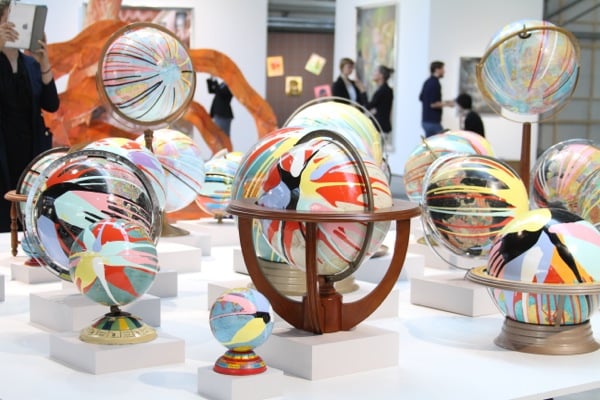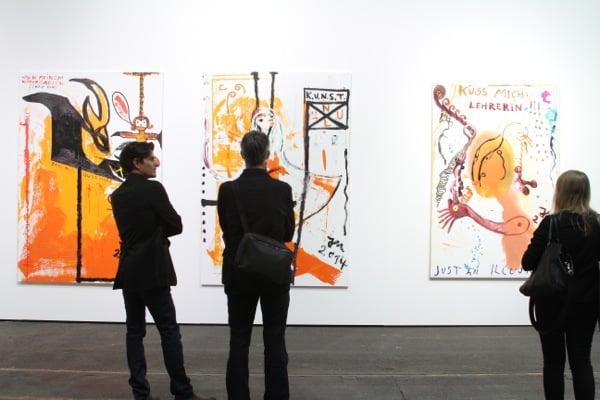Analysis
Art Berlin Contemporary Lures Fresh Collectors
Can the fair create a sustainable art market in the German capital?
Can the fair create a sustainable art market in the German capital?
Alexander Forbes

The 2014 edition of Art Berlin Contemporary (abc) closed on Sunday following a four-day run, which many gallerists were quick to report was its most successful yet. Visitor numbers were on par with 2013, at 28,000, but sales appeared to be up. That is, at least by the weekend’s close. Thursday’s preview was a relaxed affair. Friday was downright sleepy. But, as collectors poured in for the weekend, business hit a decidedly different pace. International buyers like Anita Zabludowicz, Patrizia Sandretto Re Rebaudengo, Alain Servais, and Kamiar Maleki flew in. But it’s the higher number of less prominent, German collectors that flocked to abc this year, that likely tipped the scale for this edition. It’s no small win for fair director Maike Cruse. Fellow German fair of an admittedly very different sort, Art Cologne, survives almost exclusively off the deep German market.
Entering the fair, the biggest change in 2014 was the utter lack of walls dividing the works in Art Berlin Contemporary’s first hall. Large-scale sculpture and installation reigned in the section to a welcomed extent perhaps unparalleled at any other art fair worldwide—though abc is most often described as a cross between Art Basel in Basel’s Unlimited section and New York’s Independent. That’s a return to form for the fair, which started out as an experimental sculpture show in 2008, running parallel to Berlin’s now-defunct Art Forum.
The result was admittedly slightly chaotic; it was difficult to focus fully on any single artwork. But it did set abc apart and, like most facets of the fair, was gallerist-driven. Each of the three past editions of abc has seen fewer and fewer walls erected throughout the Station Berlin. That’s due in part to galleries being more strategic about their abc expenditures. Where at most fairs walled-in booths are a given, at abc everything is offered à la carte after the €4,000 participation fee, a fee which one former fair director remarked was “remarkably low,” and which Cruse is committed to keeping stable. One international gallerist commented “I decided to pay for shipping rather than to pay for walls.”
Increasingly eliminating walls does point to the need for a slightly higher level of selectivity with regard to which works go into the self-proclaimed Verkaufsausstellung or selling exhibition in the future, however, lest it become overly theatrical or simply lack any cohesive harmony with regard to the quality of works on display. It’s something Cruse said she was considering combating by changing the format by which galleries are able to participate in Art Berlin Contemporary from invite-only—which seemingly leaves her with little recourse with regard to what artist or works those invited galleries decide to show—to open call.
A Safe Bet
Numerous dealers characterized participating at the fair as a “gamble” sales-wise. But not one I spoke with this year reported being unhappy with having made the bet—a first in the past four editions. Cruse noted that the cost of participation was about equal to or less than a full-page advertisement in most major art publications, meaning it can be used as a visibility-generation model as much as a sales platform. Curatorial attendance remained extremely high at the fair with the 2014 edition welcoming the most high-profile group in recent memory, Tate’s Chris Dercon, the Stedelijk’s Beatrix Ruf, and the Serpentine Galleries’ Hans Ulrich Obrist among them.
Several galleries explicitly reported that sales were not a factor in participating this year. “You have to ask yourself what you want from an art fair” like abc, Sebastian Klemm, from Berlin gallery Klemm’s, told artnet News. He explained that his gallery’s presentation of Peggy Buth was designed as an opportunity to reintroduce the interdisciplinary artist after two years off the scene and ahead of several institutional and gallery exhibitions. He also praised the fair as a means of enlivening a new collector base in the European market. It’s an art market that’s currently struggling, having taken a 20 percent hit to its gross output in recent years and could use such a new influx of collectors with its current base aging and no significant new generation presenting itself to take their place (“10 Things You Need to Know About Investing in Art“). “In the long run, the gallery system needs to find new people to bring in,” Klemm explained. “For that, abc works really well,” he added, noting that he invited many contacts who have yet to actively begin collecting but whose interest in contemporary art was piqued by the fair.
Recruiting Collectors
Recruiting those would-be collectors is a model that many galleries have approached with success at abc by offering works that are relatively affordable. “If you can get them to buy just one piece, you have them for life,” said one gallerist, sounding more like a peddler of crack or heroin than art. Accordingly, most sales of individual pieces at the fair fell under the $15,000 mark, some much lower.
One of the fair’s most established galleries and one of its founders, neugerriemschneider, has applied this accessibility model most-successfully two years in a row. The wall that last year held works from Pae White‘s “Smoke Carving” series, this year held around 40 works by Tobias Rehberger on a backdrop of a wallpaper that picked up where the gouache on paper and 3D printed works’ pattern left off. (Each piece came with a roll of the wallpaper against which they can be displayed at home as well.) Starting at just €2,000 a pop, they were realistic pieces for a great many past the entrance gates to acquire. They reportedly did.
Daniel Faria gallery took a similar approach with a large-scale installation of numerous globes from Generation X author and artist Douglas Coupland‘s “Optimism vs. Pessimism” series, priced at between $800–3,000 a piece.

Douglas Coupland presented by Daniel Faria Gallery (b 34)
Photo: © Alexander Forbes
As of Friday afternoon, Zürich’s Grieder Contemporary had sold nine architectural construction plans for Kerim Seiler’s Relay, a two-story wooden structure. The plans, at only €200 a piece, were an easy impulse-buy. But surprisingly, almost all of the buyers actually intend to build the work on their respective properties as well.
Higher up the price spectrum, Berlin’s Carlier Gebauer reported serious success with their presentation of photographer Richard Mosse‘s “Infra” series. A video installation based on the series garnered massive critical acclaim at the 2013 Venice Biennale. It subsequently won the Irishman the Deutsche Börse Photography Prize this year. Carlier Gebauer reported selling at least one edition of each photograph on the booth. Those started at $9,500. The gallery also sold two editions of a grid of 12 smaller photographs, each of which was priced at $6,500, making a grand total of $78,000 for each set.
Young Berlin-based gallery Duve sold out its booth of works by buzzy, up-and-coming painter, Kasper Sonne in the fair’s early moments. Each of the three canvases on show was priced at $15,000. Gallery owner Alexander Duve said that abc’s 2014 edition was “by far the best yet,” in which he had participated. Just a few booths over, brand new Dublin-based gallery Ellis King, for whom Art Berlin Contemporary was their first-ever art fair, sold out their booth of Grear Patterson. Four of the artist’s Duck Tests went for $15,000 a piece. A quirky sculpture featuring Skittles and a baseball glove also sold for $10,000. The gallery reported that the pieces went to collectors from Zürich, Berlin, Abu Dhabi, London, and Paris. And out by the fair’s entrance, Rod Barton sold out of works by American painter Luc Fuller, priced between $2,800 and $7,500.
Established galleries across the fair also reported solid sales. Sies + Höke did predictably well with a booth of new large-scale paintings by Jonathan Meese. Despite being based in Berlin, the artist had recently been less present in the city leading one prominent figure to quip “it’s nice to know he’s not dead.” Sprüth Magers bet big on abc this year, showing five artists—Walter Dahn, Analia Saban, Nina Pohl, David Maljkovic, and John Bock—at the fair. Pohl and Saban were rumored to be in particularly high demand. Lisson Gallery‘s Christian Jankowski spread works far beyond his booth’s walls, hanging neons priced between €18,000–22,000 and featuring phrases overheard at galleries and museums throughout the Station Berlin’s courtyard. They were said to be a hit with collectors; though, the exact number sold remained unconfirmed.

Jonathan Meese presented by Sies + Höke and Galerie Krinzinger (c 01)
Photo: © Alexander Forbes
That galleries have continued to devise ways to make abc work for them from both an economic and exposure standpoint is an encouraging sign for the city, which has recently been the subject of numerous trend pieces casting doubt on its continued relevance as a capital of cool. Equally heartening is the level of attention abc’s public pays to works presented at the fair. One would be hard-pressed to recall another fair format in which you could see four generations of amateurs packed three-deep in front of a work of video art on a Sunday afternoon. But, such was the case at Johann König’s presentation of Camille Henrot and Kraupa-Tuskany Zeidler and Antenna Space’s presentation of Guan Xiao. Now, to get them to take that first hit.